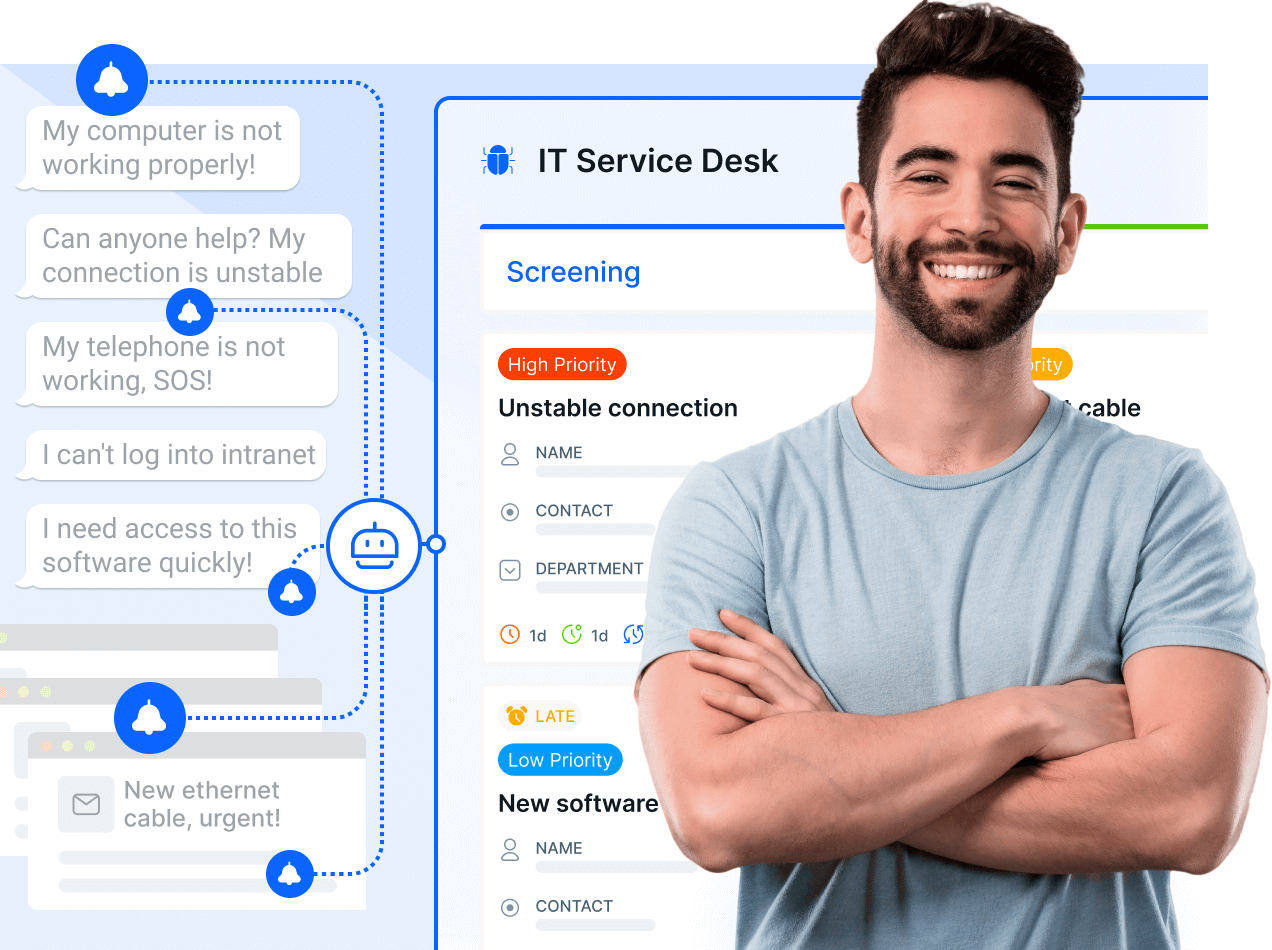
In an era where operational efficiency in IT is non-negotiable, understanding how an ITSM tool works — and how to choose the right one for your operation — is essential for those looking to accelerate workflows, automate processes, and equip their tech teams for the challenges of digital transformation. In this blog post, we will explain why ITSM Tools are the ideal choice to transform IT management.
What is an ITSM Tool and How Does It Work?
ITSM stands for IT Service Management. In simple terms, it’s all about organizing and standardizing how IT services are delivered — whether it’s handling service requests, tracking assets, managing incidents, or overseeing configuration changes.
An ITSM Platform acts as a central hub to organize IT operations based on proven frameworks like ITIL (Information Technology Infrastructure Library). With the right tool, teams can:
- Set up standardized workflows for handling and resolving tickets
- Manage SLAs automatically
- Track assets and changes in real time
- Integrate with other departments (HR, Finance, Facilities, etc.)
- Monitor performance through visual dashboards and reports
The game-changer lies in its ability to automate intelligently. With AI Agents in the mix, repetitive tasks can be handled with little to no human input — freeing up your team to focus on higher-impact work.

Why Your IT Operation Needs an ITSM Tool
Modern IT management demands speed, visibility, and scalability. Without the right structure, teams quickly become buried in emails, spreadsheets, and duplicated efforts. Here are some of the key benefits of using a robust ITSM platform:
| Benefit | What It Means |
| Standardized Processes | Clear workflows for support, changes, and incidents |
| Full Visibility | Dashboards that spotlight bottlenecks and pain points |
| IT Process Automation | Routine tasks are accelerated through automation |
| Operational Efficiency | Less rework, fewer SLA breaches, and reduced ticket loss |
| Cross-Department Integration | IT becomes a strategic business partner |
These gains are amplified with the help of AI agents that enable smart ticket triage, suggest solutions based on past cases, and trigger proactive alerts.
How to Choose the Right ITSM Tool for Your Business
Not all ITSM tools are one-size-fits-all. The right choice depends on your tech maturity, operational structure, and growth goals. Here are some key factors to consider:
1. Smart Automation Capabilities
Look for platforms that go beyond basic ticketing. The best tools support full IT process automation, conditional logic, and ideally, built-in integration with AI agents.
2. No-Code Customization
IT operations are dynamic. If your tool requires heavy coding for every tweak, it becomes a bottleneck. No-code or low-code platforms are best for making agile updates to workflows.
3. User Experience and Self-Service
A solid system should be easy for everyone — from IT analysts to end users. Make sure the interface is user-friendly and supports effective self-service, including FAQs, virtual assistants, and auto-triage. For a deeper dive, check out this article on building a user-centric ITSM.
4. Scalability and Integrations
Choose a solution that grows with your business and integrates easily with other systems (ERP, CRM, collaboration tools). IT management should be connected to your company’s digital ecosystem.
5. Actionable Insights and Reporting
Data is only useful if it drives action. The ideal ITSM tool delivers visual dashboards, smart alerts, and customizable reports to enable fast, informed decisions.
Real-World Example: Pipefy — The Flexible, Intelligent ITSM Tool
Pipefy is a standout example of how a modern ITSM platform can revolutionize service management. With a visual workflow builder, no-code capabilities, and integrations with tools like Slack, Jira, Zendesk, and Microsoft Teams, it enables teams to:
- Create smart workflows for support, change, and incident management
- Automate tasks using conditional rules and triggers
- Use AI agents for auto-triage and context-aware responses
- Track SLAs and performance indicators in real time
- Offer self-service through an accessible request portal
Beyond the help desk, Pipefy’s automation and AI features can be extended to shared services, facilities management, compliance, and governance — amplifying IT’s impact across the organization.
Bonus Reading: Automate your IT Service Management (ITSM) to handle high ticket volumes with ease
What’s Next: The Future of IT Management with AI Agents
The next generation of ITSM tools is being shaped by AI agents and smart automation. These technologies are enabling:
- Predictive incident resolution based on historical trends
- Automated technical diagnostics
- Real-time recommendations for analysts and users
- Proactive monitoring and self-adjusting of critical services.
According to Gartner, by 2027, AI agents will handle over 50% of IT support interactions — lowering costs and improving user experience.
In short, adopting an AI-ready ITSM platform isn’t just smart. It’s strategic.
Your Getting-Started Checklist: Choosing the Right Tool
Before you commit to an ITSM solution, ask yourself:
- Which IT processes need better control or automation?
- Is the IT team ready to build and manage custom workflows?
- Can the tool integrate with current (and future) business systems?
- Does it support intelligent automation and AI functionality?
- Is the platform scalable to other departments beyond IT?
Final Thoughts: Building a More Strategic IT Operation
nvesting in a modern ITSM tool is a critical step toward unlocking operational efficiency in IT. With automation, standardization, and intelligent design, your team gains time, clarity, and influence.
And with platforms like Pipefy, you can extend that smart management approach far beyond IT — connecting people, processes, and technology in one seamless ecosystem.
To further enhance operational efficiency beyond IT service management, it’s crucial to consider the broader scope of business operations. Implementing business process automation can streamline workflows across various departments, ensuring seamless integration and optimized performance throughout the organization. This holistic approach not only complements ITSM tools but also maximizes overall productivity and reduces operational bottlenecks.
→ Ready to see it in action? Book your demo today.






